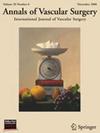腘窝动脉瘤破裂:一个病例系列和系统回顾。
IF 1.4
4区 医学
Q3 PERIPHERAL VASCULAR DISEASE
引用次数: 0
摘要
背景:腘动脉动脉瘤破裂(rPAA)是一种罕见的事件,约占手术病例的2.5%。许多患者表现为单侧腿部疼痛和肿胀,因此经常通过各种途径转诊,如深静脉血栓栓塞诊所。目的:探讨rPAA的初始诊断途径与其对肢体丧失和死亡率等预后的影响。方法:回顾性分析2007 ~ 2023年在血管外科就诊并最终诊断为rPAA的患者。记录初始诊断、最终诊断时间、肢体丧失和无截肢生存相关数据。根据PRISMA指南进行了系统审查,以评估报告的rPAA病例。结果:2007年至2022年,我院共发现需干预治疗的复杂腘动脉动脉瘤(PAA) 40例,其中rPAA 6例(占15%)。2例患者在血管评估前开始抗凝治疗,怀疑有DVT的初步诊断,导致诊断延迟6天。2例患者在发病后90天内早期截肢,另外2例住院死亡,无截肢生存率为33.3%。文献检索发现134例rPAA,包括病例报告和病例系列。高达78.89%的记录病例漏诊rPAA,并做出DVT、贝克囊肿破裂或抗凝所致血肿的初步印象。30天死亡率为13.22%,90天死亡率为27.68%,几乎翻了一番。随访30天和90天,无截肢生存率分别为80%和72%。结论:rPAA的误诊并不少见;这将延误诊断和适当的手术干预。该队列患者的死亡率和主要截肢率较高,因此确定该队列的危险因素和临床标准有助于早期诊断和及时干预。本文章由计算机程序翻译,如有差异,请以英文原文为准。
Ruptured Popliteal Aneurysms: A Case Series and Systematic Review
Background
Ruptured popliteal artery aneurysm (rPAA) is a rare event that represents 2.5% of operated cases of popliteal artery aneurysms (PAA). Many patients present with unilateral leg pain and swelling, therefore often get referred through a variety of pathways, such as deep venous thrombosis (DVT) clinic. We aim to evaluate the relationship between the initial diagnosis pathway of rPAA and its influence on outcomes, including limb loss and mortality.
Methods
Patients who were referred to vascular surgery and had a final diagnosis of rPAA between 2007 and 2023 were reviewed. Data related to initial diagnosis, time to final diagnosis, limb loss, and amputation-free survival (AFS) was recorded. A systematic review was undertaken according to Preferred Reporting Items for Systematic Reviews and Meta-Analyses guidelines to evaluate reported cases of rPAA.
Results
Between 2007 and 2022, 40 cases of complicated PAAs requiring intervention were identified in our institute, among which 6 had rPAA (15%). Initial diagnosis of DVT was suspected in 2 patients with therapeutic anticoagulation commenced prior to vascular evaluation, delaying the diagnosis by up to 6 days. Two patients had early major limb amputations within 90 days of presentation, and another 2 had in-hospital mortality, resulting in a 33.3% AFS. Literature search identified 134 cases of rPAA, including case reports and case series. The diagnosis of rPAA was missed in up to 78.89% of the recorded cases, and an initial impression of DVT, Baker's cyst rupture, or anticoagulation induced hematoma was made. Mortality was 13.22% within 30 days and almost doubled to 27.68 in 90 days. AFS was 80% and 72% at 30 and 90 days of follow-up, respectively.
Conclusion
Misdiagnosis of rPAA is not uncommon; this will delay diagnosis and proper surgical intervention. Mortality and major amputation are high in this cohort of patients, so identification of risk factors and clinical criteria of this cohort can help early diagnosis and proper timely intervention.
求助全文
通过发布文献求助,成功后即可免费获取论文全文。
去求助
来源期刊
CiteScore
3.00
自引率
13.30%
发文量
603
审稿时长
50 days
期刊介绍:
Annals of Vascular Surgery, published eight times a year, invites original manuscripts reporting clinical and experimental work in vascular surgery for peer review. Articles may be submitted for the following sections of the journal:
Clinical Research (reports of clinical series, new drug or medical device trials)
Basic Science Research (new investigations, experimental work)
Case Reports (reports on a limited series of patients)
General Reviews (scholarly review of the existing literature on a relevant topic)
Developments in Endovascular and Endoscopic Surgery
Selected Techniques (technical maneuvers)
Historical Notes (interesting vignettes from the early days of vascular surgery)
Editorials/Correspondence

 求助内容:
求助内容: 应助结果提醒方式:
应助结果提醒方式:


